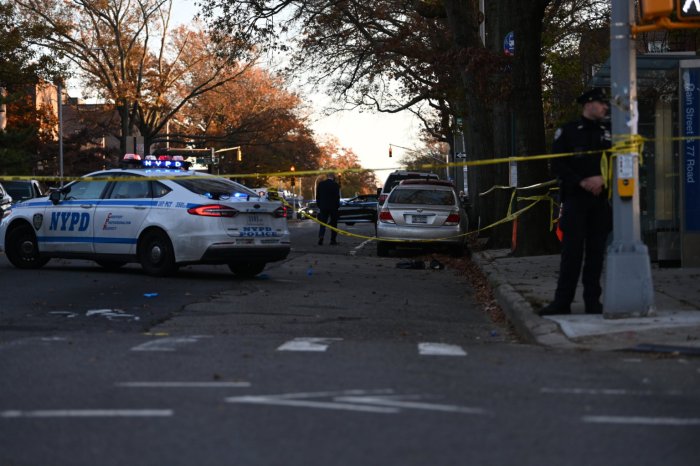By Arlene McKanic
Artist Ibiyinka Olufemi Alao, whose lecture-demonstration-exhibit “Open My Eyes,” took place at the International Resource Center at the Flushing Library Saturday, was dressed mostly in white that afternoon. Above his black slacks he wore a sparkling white double-breasted suit, a white shirt and a spotless silver tie.
He was there, in his first-rate duds, to talk about his dynamic paintings. He projected them on a screen in the front of the room, and though there was a window wall covered only by a gauze curtain on a sunny day, you could still see the vividness of the colors.
“An artist is a person with a hole in his heart that’s the size of the universe,” said the self-effacing Alao, who has been living in the United States for about a year. “So every time I make a painting it’s to fill that hole up. When I paint, I’m filling that hole bit by bit.”
Alao takes much of his inspiration from his Nigerian roots. He said the greatest artist who influenced him was his mother, since he grew up in a village where there were no art museums. But as he began to hear of artists like Chagall, Picasso and Dali he learned all he could about them.
His father, an unusually taciturn man, told him that he shouldn’t talk about the things that happened to him, but paint them. Alao also grew up reading the Bible and was captivated by the miracles within. When he didn’t find them in real life, he painted them, too.
Alao told the standing-room-only audience that African art has two themes: to convey a message from the canvas to the viewer and to convey a sense of mystery. “There’s more to the painting than what you see,” he explained. “That’s why the exhibit is called ‘Open My Eyes’ — to see beyond the ordinary.”
His paintings, which have a strong surrealist bent, are full of magic trees, skies filled with impossible stars, people wearing fabrics of kaleidoscopic colors, psychedelic suns, masks and calm, peacock-blue bodies of water, like Nigerian lagoons at sunset. “I love colors so much,” Alao said. “They express joy for me. Maybe the joy started first and I looked for colors to express it. [Nigerians] love colors. We use lots of colors in the clothes we wear.”
“Mortal Feelings,” full of people dancing, drumming and pouring out libations, explores Alao’s usual themes of peace, happiness and joy. The gently nostalgic “A Long Long Way From Home” shows women pounding cassava in a village, which is both food preparation and a ritual. In “Twin Stars of Life,” twin women happily nurse babies under crowns of leaves. “Twins are symbols of God talking twice,” Alao explained.
“The Perversity of Life,” which won the United Nations Population Fund International Poster Contest in 2001, chronicles the life of a woman from infancy to old age. “Fire In Africa” was inspired by the tribulations and wars on the continent, but even this work, with its flaming masks, is hopeful. As Alao put it, “fire burns, but also brings light.”
In “Time Melts,” with its strong echoes of Dali’s “Persistence of Memory,” a multicolored staircase climbs to a sun and sky full of fair weather clouds. A lake in the background bears numbers and hands like those on Dali’s melting watch face.
Alao’s “Vampires” depicts the insensitivity of politicians. Alao, as a West African, said he doesn’t have much use for politicians. But even this painting, with its sun, palm trees, mountains and bright colors, is tranquil and forgiving.
“Visions of Ezekiel” is a painting of hope and faith. Ezekiel was told to minister to the Valley of the Dry Bones and in Alao’s painting skeletons turn miraculously into living people. “Archi-Pleasure” has the Twin Towers as its centerpiece — it was created in 1997 — and was inspired by a stint in architectural school. “Cry Africa” is unusual because its colors and faces are somber. “We can kill each other in the name of an idea that we invent,” Alao explained.
“The Metamorphoses of Ije Moowu” recalls the legend of a barren African woman who sacrificed herself and was turned into a well. All women who drank from it became pregnant. “That doesn’t happen anymore though,” Alao said.
In “The Son Also Rises,” a tiny form walks down a sun-splashed bridge between two parting waves. It’s a retelling of the Red Sea story. In this version, said Alao, Moses uses his cell phone to have a bridge constructed over the waves to take his people across, then uses the Internet to have someone come and blow it up to stop the Egyptian advance.
“Open My Eyes” will be on exhibit at the Flushing Library through Aug. 16.




























